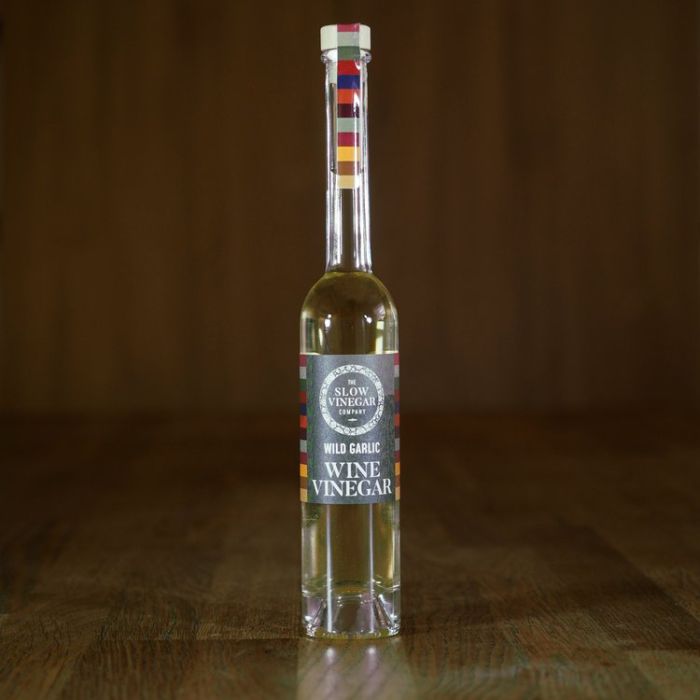
Wild Garlic Wine Vinegar - 100ml
Currently based just outside Frome in Corsley, Wiltshire, The Slow Vinegar Company was started as a way of channelling creativity and interest in food culture into the production of a traditional food staple—vinegar.
This 2 Star Great Taste Award Winning vinegar has a rich earthiness and delicate wild garlic flavour. Add to roasting lamb, roast vegetables and chicken. Mix with minced beef to make delicious burgers.
Acidity 5%
A little more detail…
Wild Garlic is a strong signifier of Spring and front runner of plants emerging after the cold winter. It’s abundance around the local rivers and streams turn the banks green and then dappled with white as the delicate flowers bloom. Often used in seasonal cooking the taste of wild garlic is distinctive and familiar.
Making Wild Garlic Wine was quite something - never before has a fermenting brew smelt so strong, so pungent, a moment when we had to question whether we were doing a good thing! However, as the wine matured, that phase passed and as the vinegar developed the flavour and aroma became more subtle and complex.
The finished vinegar has a presence of the base ingredient both in aroma and taste and will be a good staple savoury ingredient for many dishes.
Best Before - Use By Dates - Vinegar Storage
We all understand that Best Before labelling is a vital part of food production, in place to protect the consumer.
Vinegar, however, is a preservative and as such doesn't need to display Use By or Best Before information. In the EC1169/2011 directive which applies to Food Labels, Vinegar is an exempt product for the purposes of marking an expiry date.
This information became clear to us after we had printed some bottle labels. Consequently some of our bottles carry the text BBE (Best Before End) and a mark on their neck—2 years from purchase date.
It is safe to say though that our vinegars will only mature and improve with age. The cost of some of the most expensive vinegars available is often based around its age.
The one thing that does affect vinegar is exposure to air. This is why they are traditionally bottled in narrow bottles in order to reduce the surface area in contact with the air. While unopened bottles will last and improve, open bottles will react to exposure to air. Over time flavours will fade, so our advice is to keep using the vinegars once they are opened.
Storage is best in cool, dark conditions.
Mother of vinegar
There is a lot written about the Mother of vinegar and its presence within vinegar making processes. Basically, when alcohol ferments into vinegar, the Mother of vinegar is driving this change. The Acetobacter aceti, (good bacteria and proper name for the Mother), responsible for this transformation / fermentation, are present naturally and controlling them in our production process is one of our challenges. While Mother of vinegar is the common name given to the acetobacter, it can appear in a more cp957_visible form as a gelatinous disk floating on the surface of fermenting alcohol / vinegar. Comprising primarily of cellulose, it is harmless if accidentally consumed, but not recommended!
The Mother of vinegar is present in all our vinegars as we don’t use any pasteurising process which would kill the acetobacter. Because the vinegars contain ‘live’ bacteria, occasionally a small jelly like disk may form on the surface of the vinegar in the bottle. As already mentioned, this is harmless and can easily be removed, discarded or ignored. The rest of the vinegar does not need to be discarded.
Nutrition
Trading standards and the regulations surrounding food labelling are strict and well regulated. Usually and for good reason, packaged foods need to display their nutritional values.
Fermented vinegars are exempt from the need to display nutritional values on their packaging. However, we have gone to the trouble of obtaining this level of analysis on our vinegars so you can be sure about their contents.
| Energy (kJ/100ml (kcal/100ml)) | 78 (18) |
| Fat (g/100ml) | <0.5 |
| —of which saturates (g/100ml) | <0.5 |
| Carbohydrate (g/100ml) | <0.5 |
| —of which sugars (g/100ml) | <0.5 |
| Protein (g/100ml) | <0.5 |
| Salt (g/100ml) | <0.01 |
